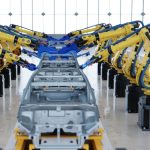Tesla is making significant strides with its Cybercab project by introducing distinct castings at its Gigafactory in Texas. This development precedes the vehicle’s anticipated launch and highlights Tesla’s ongoing commitment to expanding its autonomous vehicle lineup. The initiative reflects Tesla’s broader strategy to innovate within the electric vehicle market and enhance its manufacturing capabilities.
Recent observations by Joe Tegtmeyer on X revealed that the newly produced castings at the Gigafactory differ from those of the currently manufactured Model Y and Cybertruck. These castings exhibit a unique single-piece design, suggesting a shift towards more streamlined production processes tailored for the Cybercab.
How Are the Cybercab Castings Different from Current Models?
The Cybercab castings distinguish themselves through a single-piece construction, contrasting with the two-piece designs used for the Model Y and Cybertruck.
“Our design approach for the Cybercab emphasizes structural efficiency and manufacturing simplicity,”
a Tesla spokesperson stated.
What Production Methods Are Being Utilized for the Cybercab?
Tesla is employing its unboxed production process for the Cybercab, which involves creating single-piece castings. This method aims to reduce assembly time and costs while maintaining high-quality standards.
“The unboxed process allows us to build components more efficiently, paving the way for faster production cycles,”
explained Lars Moravy, Tesla Vice President of Vehicle Engineering.
When Is the Cybercab Expected to Enter Production?
Prototype builds for the Cybercab are scheduled to commence this summer, with plans to scale up to volume production by 2026.
“We are on track to begin prototype testing shortly, with full-scale production aimed for the next few years,”
Moravy added.
The introduction of the Cybercab castings at Gigafactory Texas marks a pivotal advancement in Tesla’s vehicle production strategy. By adopting the unboxed production process, Tesla not only enhances its manufacturing efficiency but also sets the stage for launching its first commercial robotaxi services. This move is expected to solidify Tesla’s position in the autonomous vehicle market and drive innovation in electric transportation solutions.










